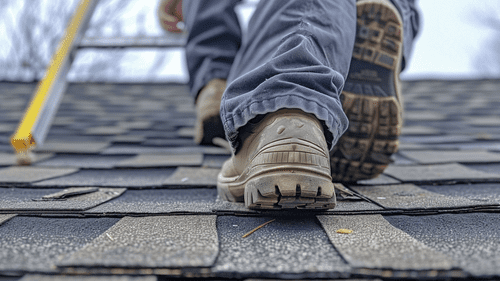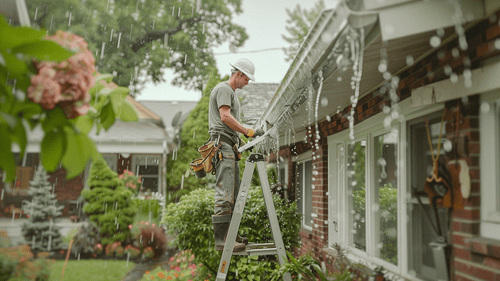Replacing a roof takes a long time, but it’s actually more manageable than you might think. The duration hinges on several factors, including the material you choose and the size of your roof.
Workers can finish a small roof in a day, while they may take a week for bigger projects. Weather conditions and the specific replacement method also play a pivotal role.
To get a clearer picture of what to anticipate for your project and why these factors matter, it is crucial to explore further.
Determining Factors
Knowing what factors affect how long your roof replacement takes is important for planning and setting realistic timelines. The roofing material you choose plays an important role in shaping your roof replacement timeline. If you opt for asphalt shingles, you’re looking at a relatively quick process, typically taking 1-3 days. On the other hand, metal roofing can extend the project to 7-14 days because of its complexity in installation.
Weather conditions are another significant factor that can influence the timeline. Bad weather, such as rain or extreme temperatures, can cause delays in starting and completing your project.
Inclement weather can lead to project delays and prolong the duration of your project. To mitigate these risks, it is wise to plan your replacement during a season known for mild weather.
Unfortunately, unexpected delays are a part of life, and your roof replacement project is no exception. Issues like unforeseen damage can arise during the project, causing additional repairs and delays in completing it on schedule. Prepare for unexpected delays by adding extra time to your project schedule to stay on track despite any surprises.
Roof Size and Complexity
When replacing your roof, remember that the size and complexity of your roof can affect how long it takes. Also, consider the materials and weather conditions. The roofing industry acknowledges that larger roofs naturally demand more time for completion. Yet, it isn’t just about roof size; complexity plays a significant role too.
Complex roofs with many angles and slopes need extra materials and careful attention to detail during construction. Fixing special features correctly makes replacing a roof take longer due to these challenges.
Furthermore, one must not overlook safety precautions, especially on complex roofs. These roofs often necessitate additional safety measures to protect the workers, which can slow down the overall replacement timeline.
Simple roofs, in contrast, with fewer intricacies, tend to be quicker to replace. The absence of elaborate designs means fewer obstacles to navigate, allowing for a more streamlined installation process.
Understanding how the size and complexity of your roof will impact the time it takes to replace it is important. Whether your roof is large and elaborate or small and basic, these factors will play a role in the replacement process. Knowing this information can help you plan accordingly and anticipate any potential delays.
Material Considerations
Choosing the roofing material can impact the length of your replacement project. Options like asphalt or slate can affect the timeline.
If you choose asphalt shingles, we can finish the job in 1-3 days. Asphalt shingles are easy to install in strips, making them a popular choice for homeowners seeking efficiency and cost-effectiveness.
On the other hand, wooden shingles might extend your project’s timeline to about 6-8 days. Placing these shingles individually takes longer and requires precision, but the attractive look they provide may be worth it. Slate tiles, known for their durability and unique appearance, also require a significant amount of time, usually around 6-7 days for replacement due to their intricate design.
Metal roofing presents another quick option, akin to asphalt shingles, with replacements typically completed within 1-3 days. This roofing material is admired for its longevity and modern look, offering a swift yet sturdy solution for your roofing needs. Each of these roofing materials has its own set of characteristics that influence the duration of your roof replacement project, so consider your priorities and make your choice accordingly.
Weather and Timing
After exploring the impact of materials on the timeline, it’s important to emphasize how weather plays a significant role in roof replacement projects. You’ve probably realized that the type of material and the size of your roof are key factors, but don’t underestimate the influence of weather conditions. Whether it’s rain, extreme temperatures, or storms, bad weather can force crews to pause their work, directly affecting your project’s timeline. It’s not just about delays; safety and the quality of installation are at stake during adverse weather.
Extreme weather conditions, in particular, can significantly slow down the roofing crew. Even with precautions like using tarps to protect exposed decking, there’s only so much that can be done until the weather clears. This is why planning your roof replacement during seasons with more favorable weather, typically late spring to early fall, is a smart move. Not only does it minimize the risk of delays, but it also ensures that the crews can work efficiently and safely.
Replacement Process Steps
The roof replacement process starts with removing your old shingles, a critical step to guarantee a solid foundation for your new roofing material. Next, the roof deck is meticulously inspected for any signs of damage. Should any issues be identified, these areas are repaired or replaced to ensure they can adequately support the new roofing materials. This preparation is key to the longevity of your roof.
Following the prep work, an underlayment is applied to provide an additional layer of protection against water. The type of roofing material you’ve chosen is then installed. Whether it’s asphalt shingles, wood shakes, slate, concrete tiles, or metal roofing, each material has its specific installation steps and timeline, influenced by the size and complexity of your roof as well as weather conditions.
Flashing and ridge caps are added to further protect against water infiltration, particularly in areas prone to leaks, like valleys and around chimneys. The final step in the roof replacement process involves a thorough cleanup of the area to remove any debris or leftover materials.







